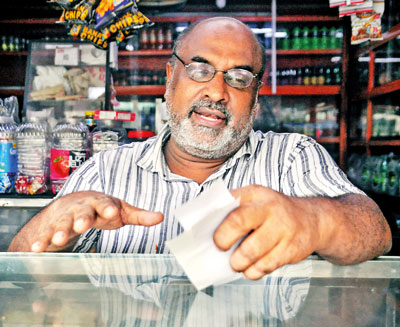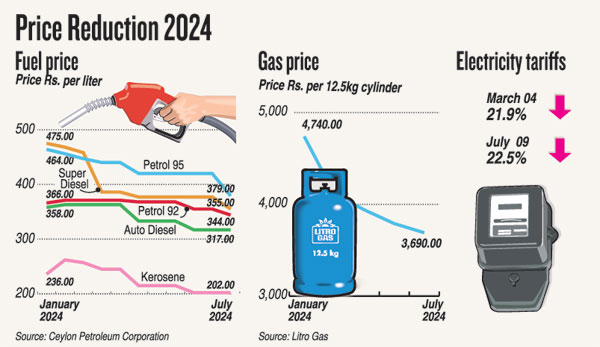News
Goods retailers determined to hold high prices despite tariff trimming
View(s):By Nathara Abeywickrema
Despite the recent reduction in monthly electricity tariffs, various sectors report that the anticipated benefits cannot be passed on to people. This is due to significant increases in other operating costs.
President of All Ceylon Bakery Owners’ Association, N.K. Jayewardena said electricity is a substantial part of the operating costs for bakeries, which rely heavily on ovens, refrigerators, and other equipment.
Monthly tariffs for industry were reduced by 25.3% just days ago. Business chambers have reacted positively.
The recent lowering of electricity tariffs should, in theory, ease some of the financial burdens of these businesses. Yet, bakery owners are quick to point out that electricity is only a small part of their overall costs.

H.M. Shajahan runs a bakery
The prices of key baking ingredients such as flour, sugar, butter, and eggs, have risen sharply over the past year.
“While we are grateful for the lower electricity bills, the cost of our main ingredients has gone up dramatically. Flour and butter, in particular, have become much more expensive, making it impossible to lower our prices,” he said.
Prices of bakery items will therefore not be reduced.
In the meantime, the price of a pack of rice and curry was reduced by Rs 25. The price of fried rice and Kottu were reduced by Rs. 25, while prices of paratha, egg roti, and snacks dropped by Rs. 10. The price of plain tea was reduced by Rs. 5.
Restaurant owners, too, are finding it impossible to pass on savings to consumers, they say.
President of the All-Ceylon Restaurant Owners’ Association, Harshana Rukshan said soaring prices of essential ingredients like palm oil and coconut oil are preventing any significant reduction.
There has been an increase in the price of palm oil, a critical ingredient for many small-scale restaurants. A kilogram, which previously cost Rs. 600, is now Rs. 780. This 30% price hike is putting a significant strain on restaurant budgets, he said.
“We understand that customers are expecting lower prices because of the electricity cost reduction, but the reality is that our other expenses have risen so much that it is simply not feasible,” explained Mr. Rukshan.
Price of restaurant food can not be reduced, because, despite a price control of Rs. 130 for samba rice, it is sold at Rs. 230, and keeri samba, with a control price of Rs. 260, is sold at Rs. 320. This needs to be regulated, and the Ministry of Trade should focus more on addressing these discrepancies.
He also said that the price of a milk tea may be lowered if the cost of milk powder also dropped further.
“Until these ingredient prices stabilise, we have no choice but to maintain our current prices,” he said.
The cost of an electricity unit, which was formerly between Rs 2.50 and Rs 3, is Rs 6, indicating that tariffs are still more than 50%, said Sanjeewa Dhammika, secretary of Electricity Consumers’ Association.
Last week, the minister reduced the payment for rooftop solar power from Rs 37 to Rs 27. But later the Govt. instructed the CEB to go back to Rs. 37. The minister is also planning emergency purchases at Rs 120 in January and December, leaving 50,000 in a difficult situation.
For small business owners, the situation is even more pronounced.
H.M. Shajahan, who runs a bakery in Maradana, pointed out that while the drop in electricity tariffs is appreciated, other cost increases have eroded any gain. “We have had to deal with higher prices for ingredients and packaging, which have risen sharply. The reduction in electricity bills helps, but it is not sufficient to lower our prices without compromising our profit margins,” he explained.

A.H.M. Jemin: Proprietor of a welding shop. Pix by Nilan Maligaspe
Convenience store owner Lasantha Kumara other costs related to the store are still high.
Thyagaraja Muralidaran, who provides salon services in Maradana said electricity use is high and the equipment is very expensive.
The proprietor of a welding shop, A.H.M. Jemin claims that he can not reduce prices because he takes on jobs as they come.
National organiser of the Small and Medium Business Owners Association, Niluksha Kumara said skyrocketing shipping costs are a critical factor in prices.
Shipping costs from China has surged by 300%, amounting to US$3,500-US$4,500 drastically increasing the cost of imports. This surge is attributed to a combination of global supply chain disruptions, increased demand for shipping containers, and lingering effects of the coronavirus pandemic on international trade.
The reduction in electricity prices is great, he said, but it is overshadowed by the astronomical rise in shipping costs.
However, an official from the Consumer Affairs Authority (CAA) added that implementing a price control would not be practical due to the highly variable costs of production and distribution. These fluctuations make it difficult to set a fixed price that accurately reflects market conditions and ensure fair compensation for producers and suppliers.
The CAA has mandated that every shop must display prices. Raids are planned in the coming weeks to enforce compliance and address violations.
Meanwhile, price controls for specific items may be necessary if business do not pass on concessions to consumers, according to Minister of Trade, Commerce, and Food Security, Nalin Fernando. Amendments to the Consumer Act would be brought before Parliament in the next two weeks, he said at a briefing Friday.

| Import and other costs passed on to consumers Rising import costs, particularly ocean freight rates, is nothing new to Sri Lanka’s traders and importers usually pass on their costs, as well as what they pay in duties and levies, to Sri Lanka’s consumers. Domestic taxes imposed on goods also substantially inflate consumer goods prices. Container shipping costs have been soaring since July 2023, for example, and had been on a climb since the coronavirus epidemic that spread from China in 2019. A global index shows that in July 2023, the weekly, 40 foot container freight rate was US$1,400 and a year later, it has rocketed to US$5,937. That is a 286% increase from the year before. And it is 318% above the average pre-pandemic rate of US$1,420. But, apart from choosing the right terms for shipment, such as free-on-board and cost, insurance and freight, importers also have the choice of using 20 foot containers for heavy cargo and 40 foot containers for high volumes, to make the best of high rates. Spot market rates have also surged by 200% in the first quarter alone, global shipping portals show. The Red Sea crisis has been described as ‘Christmas’ for shipping lines.-KB | |
The best way to say that you found the home of your dreams is by finding it on Hitad.lk. We have listings for apartments for sale or rent in Sri Lanka, no matter what locale you're looking for! Whether you live in Colombo, Galle, Kandy, Matara, Jaffna and more - we've got them all!

